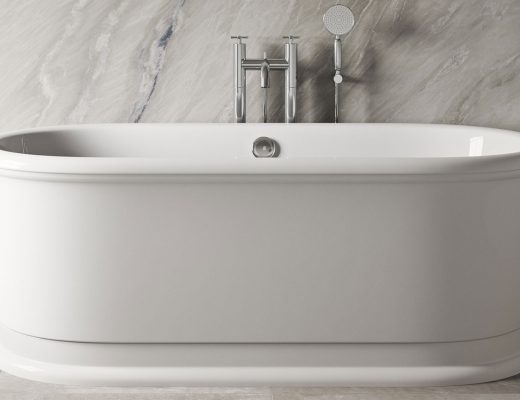Looking for a new way to elevate your kitchen or bathroom? Enter: tile drenching – the latest decorating trend on our radar.
Colour drenching (picking one shade and using it throughout the scheme, from paint and furniture to soft furnishings) is the root of some of the latest decorating trends. Swapping colour for bold patterns has recently gained traction and it’s the perfect technique if you are more of a maximalist. But what about using tiles to achieve a stand-out look? We’re exploring the ins and outs of this design idea…

So, what is tile drenching?
Similar to colour drenching, tile drenching is all about using a single tile design to saturate the room. “The goal of this trend is to create a bold and immersive look, often using the tile to cover the walls, flooring, and sometimes even fixtures such as wall-hung basins or showers. This trend is a particularly popular choice for those seeking a sleek and modern design in their bathroom or kitchen,” explains Molly Woodward-Moor, designer and creative director at Stone Superstore.
It’s a versatile decorating trend, and with the wide range of tile styles, shapes and materials available these days, it suits different aesthetics – from modern to rustic. Intrigued? Then let’s find out how you can make it work in your kitchen or bathroom.

Where to start
There are a few key elements to think about before beginning your makeover project. If you’re keen to welcome this trend into your home, having a clear vision of the aesthetic you want to achieve and deciding on the colour palette that compliments your theme are good starting points.

“The 60-30-10 design method is a good rule of thumb and will help you create a clean and consistent colour palette, starting with your statement colour which should be allocated to 60% of the room, meaning this will be your tile colour,” advises Molly. “Your secondary shade should cover 30% of the room to add depth and visual interest to the space, complementing your statement shade. In terms of the bathroom or kitchen, this could be added through the towels, bathmats, or window treatments.”
To tie the look together and add contrast, use an accent colour. “The accent shade could be used in small décor pieces like artwork, taps or knobs,” says Molly.
For a calming effect, lean into soft neutrals, cool blues and greens. Jewel tones and deep, saturated colours are better suited for a bolder look, recommends Louisa Swannell, head of creative design at Walls And Floors.

Small or large-scale tiles?
Depending on the style you want to achieve, and your budget, you can choose between small slabs and large-format tiles. “Large format tiles can create a more seamless, expansive look when covering walls and floors whereas smaller tiles or mosaics can add texture and interest, but should be used with care as they can disrupt the continuity if not chosen carefully,” says Colin Lincoln-Evans, buyer at Tile Mountain.
Marble- and onyx-effect tiles with statement veining are incredibly popular at the moment – ideal for achieving a luxurious, stone-drenched kitchen or bathroom without breaking the bank.

If you dare to go even bolder, you can also opt for decorative tiles, which are ideal for a maximalist scheme, or you can have fun and create your own pattern such as chic stripes. To achieve this popular look, you’re going to need square or metro tiles in complementing or contrasting colours. “When drenching with tiles, experiment with different tile textures or laying patterns for example, using a metro tile in a herringbone pattern on the floor, whilst using the same tile in a vertical design on the walls. This will maintain visual interest and avoid monotony, without breaking the tile-drenching effect,” says Molly.
Seek advice from your kitchen or bathroom designer to discover all the clever ways of making an impact in your space with tiles.

Key considerations
Now, let’s talk practicalities. It’s crucial to think about the size of your space when choosing your tiles. “For smaller bathrooms, lighter colours can make the space feel larger, while darker colours will create a more intimate, cocoon-like atmosphere,” says Louisa.
The finish of your slabs is equally important. Matt tiles are perfect for modern kitchens or bathrooms, however, if you’ve got a compact space, then glossy solutions are a better choice to help bounce light around the room and give the illusion of a more open scheme. “The colour and finish of the tiles can influence how light is reflected in the space so be mindful that a single colour tile scheme may make a room feel flat or cold if not balanced with the right lighting,” she adds.

Kitchens and bathrooms are hardworking spaces so your tiles need to ultimately suit all the different areas – from the walk-in shower to the sink zone. “Opt for tiles that are both durable and appropriate for the surfaces you are covering; for floors, make sure the tiles have sufficient slip resistance, particularly in wet areas,” advises Colin.

Lastly, don’t overlook the cost. Plan your budget carefully and make sure you’ve also got extra slabs to avoid any surprises along the way. “While tile drenching can create a luxurious effect, covering large surfaces with the same tile can add up in cost. Balance your budget by considering where to apply tile drenching fully and where you might incorporate complementary materials or finishes in less prominent areas,” says Colin. For more tile buying tips, click here.




